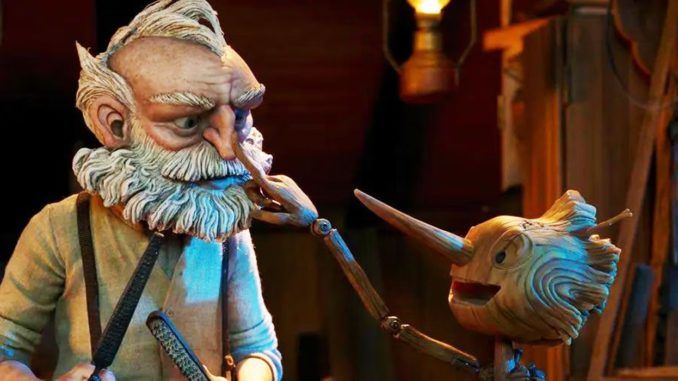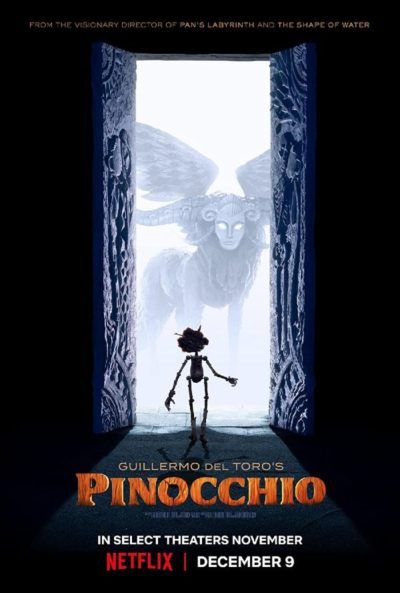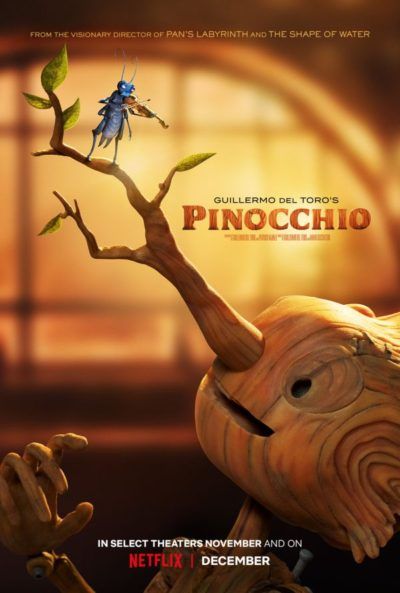
Rating: D
Dir: Guillermo del Toro and Mark Gustafson
Star (voice): Gregory Mann, Ewan McGregor, David Bradley, Christoph Waltz
Jim: Been a bit of a rush on Pinocchio adaptations of late. This is the third released in 2022, after a Russian, traditionally animated version, and the Disney live-action remake starring Tom Hanks as Geppetto. Neither were warmly received. But Guillermo del Toro has been working towards this for a long time. His adaptation was first announced in 2008, with the stop-motion medium being confirmed as long ago as February 2011. However, del Toro’s commitment to that approach needed a hefty budget commitment, and studios balked at the price, especially given the defiantly non-commercial setting of fascist Italy. Netflix eventually picked it up, in the wake of del Toro’s success with The Shape of Water. In 2020, he said he needed $35 million to make it, which actually seems cheap considering the budget on the Disney version was more than four times as much.
The basic story likely needs no description, but this goes darker from the start. Geppetto (Bradley) carves Pinocchio (Mann) as a replacement for son Carlo, killed in a World War I bombing. Indeed, the wood used comes from a pine tree planted to mark Carlo’s grave, before being brought to life by a wood sprite. Pinocchio is quite a wilful child, who joins the circus of Count Volpe (Waltz), and whose apparent immortality brings him to the attention of the local fascist mayor, and eventually to Mussolini. Geppetto tries to find Pinocchio, only to be swallowed by a sea monster. After escaping from both Volpe and the fascists, he is (conveniently!) eaten by the same creature. In order to save his father, Pinocchio becomes mortal – yet rather than becoming a flesh-and-blood boy, retains his wooden body.
So, what did you think, Phil?
Phil: Oh-Boy-Oh-Boy-Pappa!! This must be the best review ever! But. To digress. Just after Christmas I went to Sadler’s Wells here in London to watch a ballet choreographed by Matthew Bourne. The production was Sleeping Beauty. The story of Sleeping Beauty has evolved through many iterations and tellers, with a few of them being a lot less family and ballet friendly than the version we currently have. So? Well, I wish that this film had been taken from another story variant than the one they used.
However, the problem isn’t only with the film itself, it also stems as much from inevitable comparisons. Or more accurately the film to which it will be compared: A Nightmare Before Christmas. And, oh boy, it doesn’t fare well.
 “Oh-Boy-Oh-Boy-Pappa!!”
“Oh-Boy-Oh-Boy-Pappa!!”
This is beautifully done. Impeccable, incredible, meticulous and set about with a myriad of deft touches of light and shade. It has some genuinely funny moments, some magically inventive and, in some segments, also the feel of a deeply dark and foreboding nightmare. Claustrophobic. A helter-skelter of cascading panic.
“Oh-Boy-Oh-Boy-Pappa!!”
Given that he was considered such a talented sculptor, it remains unclear to me why Geppetto carved Pinocchio’s head to be that (broadly) of Wilson from Castaway. Although this might explain the very generous description of him being “quite a wilful child”. Alternately the ‘boy’ could also be called a freewheeling whirlwind of self-obsessed psychopathic destruction, and I’d be fibbing if I said that things went well for the mismatched pair. Instead and indeed things go un-well, and very quickly so.
“Oh-Boy-Oh-Boy-Pappa!!”
However all is not lost, as living in the boy’s heart is Obi-Wan ‘Ben’ Kenobi Sebastian J. Cricket, and it is to him that the old man and the sprites ‘kindly gift’ the role of guiding the unruly and hugely irritating psychopath with whom the force is strong, and whose limbs are as disjointed as the ‘narrative’ herewithin.
“Oh-Boy-Oh-Boy-Pappa!!”
This is a two hour film that ideally would have been closer to eighty minutes, maybe less. By the time forty minutes were up, I had really had enough of it and would normally have switched off as, ironically, it has no heart, no soul. It feels hollow, oddly overly-constructed yet incoherent and I really did not care. Instead I spent most of the film wanting either character to die. Or better yet, both of them.
“Oh-Boy-Oh-Boy-Pappa!!” (…is it grating yet…?)
“Oh the pain!”
“SHOOT THE PUPPET!!!”
Sadly, for almost the entire film, I couldn’t get the Mitchell and Webb sketch about ‘Pappa and Pinocchio’ out of my head. The one that involves the wood-chipper.
“Oh-Boy-Oh-Boy-OH-BOY-Pappa!!”
As you may have guessed, I really did not like this film, but then I’m not its target audience. But I still didn’t like it, and that’s not true of all children’s films. Look, there’s lots of good ideas and vivid imagination on display here, and there are plenty of cute moments and engaging themes within. However, nothing felt coherent or connected or consequential, and it seemed oddly disjointed as if fired from a scatter gun before being sellotaped together, and overall I found it hugely uninvolving and a real struggle to watch.
Oh, there’s also some sporadic singing in it too, unhelpfully, should we loop back to making comparisons.
 Jim: I’m really not sure who is the target audience for this, outside of Guillermo del Toro. It seems to inhabit an uncanny valley, where the childish nature (in both ways) of the protagonist will be off-putting to adults, yet kids are unlikely to appreciate the darker tone and themes, never mind the 114-minute running time. Was anyone asking for a stop-motion adaptation of Pinocchio set in fascist Italy? I tend to agree with studios who passed on the concept.
Jim: I’m really not sure who is the target audience for this, outside of Guillermo del Toro. It seems to inhabit an uncanny valley, where the childish nature (in both ways) of the protagonist will be off-putting to adults, yet kids are unlikely to appreciate the darker tone and themes, never mind the 114-minute running time. Was anyone asking for a stop-motion adaptation of Pinocchio set in fascist Italy? I tend to agree with studios who passed on the concept.
I do get the ideas for which Del Toro was going. For instance, Pinocchio retaining his original form rather than turning into a real human boy at the end, is because it’s what’s on the inside that matters, rather than outward appearance. Except, by this point it all seems a rather token gesture. I didn’t have much sympathy for Pinocchio, because it felt like his problems were almost all of his own making, resulting from wilful disobedience. I felt more sympathy for Geppetto. Hell, I was closer aligned with the fascist mayor, which I kinda doubt was the intention.
It is an ugly-looking film, almost defiantly and certainly intentionally so. This begins with Pinocchio, who has a face only a termite could love, which kept reminding me of the famous quote from Jaws: “lifeless eyes, black eyes, like a doll’s eyes. When he comes at ya, doesn’t seem to be livin’.” But this is just not a universe which seems to contain much beauty, or warmth, or humanity. Oh, technically, it’s undeniably impressive. I’m a sucker for stop-motion, be that the dinosaurs of Ray Harryhausen or the works of more obscurist creators like Jan Svankmajer’s Alice. It’s an almost lost art. But there’s perhaps the issue: I like my art to uplift, and this rarely comes anywhere close to that.
As in the original Disney animated version, Sebastian J. Cricket (McGregor) represents the moral compass, and is probably the movie’s most likable character. Though here, I was mostly impressed by the sheer resilience of the little critter, who survives squishing on multiple occasions, like some kind of Terminator Insect. He was certainly more memorable than any of the musical numbers. When I read Phil’s comment about “sporadic singing”, my reaction was, “Wait, I don’t remember any singi… Oh, yeah: I guess there was.” I honestly couldn’t hum a single note, and you wonder why they bothered at all.

I did feel it improved somewhat towards the ending: the sequences with the sea monster were particularly impressive. The film seemed to forget all pretense towards weightier topics, in favour of simply telling an exciting story, and was all the better for it. But never mind the songs, beyond the visual style, there was not much which stuck in my mind, and all the signs are that it will quickly be forgotten. In the US, it managed just two weeks in Netflix’s top ten, peaking at #3. Worldwide, in its debut week, it was beaten in viewing hours by… Lady Chatterley’s Lover. Yes, people were more interested in Emma Corrin’s tits than this. Me, I’m wondering what I missed out on there. Answers to the usual email, please.
It is likely going to win the Oscar for Best Animated Feature, though looking at the qualifying candidates is mostly a ringing condemnation of what a crap year it was for the medium. [Sadly, Emma Corrin’s tits are ineligible for the category] That’s likely to be the end of its impact on popular culture. I can’t see it becoming a beloved classic in 30 years, wheeled out annually like The Nightmare Before Christmas, and the odds of it being as well-respected in the year 2104 as Disney’s animated Pinocchio, seem even bleaker.
Phil: This is one of those films that I watched without any precondition or expectation, happy to go where the confection led me, and “a face only a termite could love” made me laugh. Now, fetch me a wood-chipper for, as Jim accurately states, it “…is an ugly-looking film”.
Bottom line for me is that it doesn’t come anywhere close to A Nightmare Before Christmas. The story is too thin, disjointed and the childish morality tales are too childish. The highly questionable ‘inclusion’ or overlay of the two world wars left me coldly confused, and I’d suggest that you avoid this if you’re over twelve years old, otherwise… …well, it may be a decent film. It’s just that I can’t tell.
So, two scores. ‘D-‘ for grown-ups and ‘\o/’ for those under twelve, and in the meantime I’m off to Google Emma Corrin’s tits… oh boy oh boy…
What says you Jim?
Jim: I wouldn’t sink quite as low as D-, simply because it’s stop-motion and deserves credit for being such. But, as an example of the medium, it’s weak sauce indeed, which really does little to explore the freedom offered. Henry Selick is still disgruntled Tim Burton put his name on Nightmare. I suspect Mark Gustafson may secretly be glad Del Toro put his on this. D+ for me.
